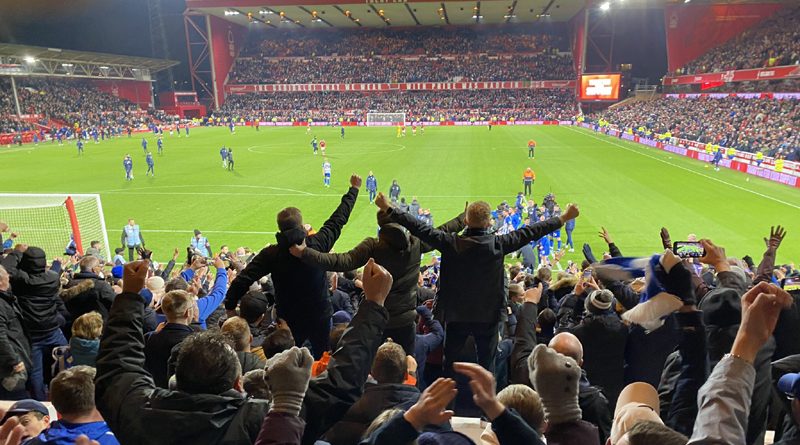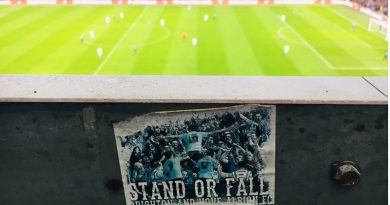Tackling the issue of a generational divide between Brighton fans
Like a number of Brighton fans who grew up before the days of modern forms of social media and smart phones, I love reading local newspapers and looking up what others are saying on the unofficial fans forum North Stand Chat to see what the word on the street is about all things Brighton and Hove Albion.
There is something rather comforting about the simplicity and unrefined nature of an internet forum. A form of social media that dates back to the days of dial up broadband and personal computers sat in the corner of the living room connected to a processor the size of an arm-rest.
It is a medium which many would now consider outdated, but which to me is refreshing. A medium I find has far less of the mob mentality and is not as in your face as modern forms social media.
Somewhere that the uninformed and outrageous opinions of individuals prosper far less but far more where people commune to simply discuss and argue over a topic of particular interest to them.
After the second leg of the Europa League round of 16 tie against Roma, one North Stand Chat user posted reminiscently about how his 25-year journey as a Brighton fan (coincidently the same length as mine) had led up to this point. He wrote about how so much had changed over that time and how special his journey had been.
I was also thinking about this at the end of the Roma game. My mind went back to my first Albion game, a 1-0 win over Hartlepool at Withdean Stadium on a cold November day in 1999.
It was a scrappy fourth tier game won by a close range header from a corner by Keith McPherson in front of around 6,000 people. Simpler times.
At my secondary school near Eastbourne in East Sussex, I was one of the few Brighton fans. The only others in my year group were two friends of mine who were begrudgingly dragged along to games with me.
These days, you can’t move for Brighton shirts on non-uniform days at schools across Sussex. Some of these young Albion supporters wear rehashes of the same 1999-20 Skint shirts I was regularly teased for wearing on my own non-uniform days when I went to school.
I live in South East London now and on the road I moved to a couple of years ago, there is a house (not mine) with a Brighton car sticker in their front window.
Occasionally, I go to local Parkruns on Saturday mornings where I often get talking to other Brighton fans due to my Albion attire.
And these days if I am wearing something Brighton related when out and about in my local area, it will instigate a conversation about the recent success of the club.
It used to be that Albion merchandise simply led to confused looks and questions like: “What league are you in nowadays, then?” Or a confused: “Brighton, who? Well, good luck to you!”
I find it mad how things have changed and regularly find myself looking back to those early Withdean Years. Bobby Zamora, Michel Kuipers, Danny Carpenter and the rest lighting up the Theatre of Trees in my mind took place simply a few years ago, when it has actually now been a quarter of a century since the club moved there.
In fact, it has been nearly as long since the Albion took up residency at Withdean (1999 was 25 years ago now) as between the 1983 FA Cup final and the Amex opening (28 years).
The FA Cup Final feels like ancient history to me with no living memory of it; for those who went from Wembley to the Amex, losing to Manchester United under the twin towers must have felt as recent as those Zamora goals and Kuipers saves.
These elements of the club’s history stick with us as supporters; they define what the club is in our minds. But with time, that essence of a club really can change. And we need to be willing to adapt and change our mindset with it.
Take those club ranking posts you regularly see on social media, for example. Massive club, big club, small club, tinpot and the rest.
You can often tell what teams were in the top flight during that person’s youth dependant on who they consider to be a big club… particularly if they call Portsmouth a big club. Portsmouth?! Come on, give over!
Brighton fans of my generation experienced many older fans harping on about 1983 and all that in our youth, or regaling of the brilliance of players like Peter Ward and Mark Lawrenson.
No doubt in a decade or so, many of this current generation of Albion supporters will instead be regaling of Lewis Dunk, Pascal Gross and the great Albion team that ventured into Europe to the next generation of disinterested youngsters.
Seagulls fans do not just hold good players in regard. Those who supported the club in lesser times like my generation instead regal in the awfulness of Brighton teams from our youth.
Colin Hawkins, anyone? You think you have seen a strike force which couldn’t hit a barn door with a banjo? You never saw Paul Kitson and Graham Barrett lead the line!
Back in the 1990s and early 2000s, the club was a huge drain on the local economy and its image. Particularly during the period where the club’s supporters were protesting against its owners to the outrage of the national media.
It is this sort of reputation the Albion gained which no doubt aided the cause of both Withdean and Westdene residents, who campaigned against the club’s move back to the city via the local athletics track.
Falmer residents then followed in their lead, using threats of football fans destroying their local area to support their campaign against building a new stadium in the area.
By the time the Albion left Withdean after 12 years, those same residents celebrated the League One title win in their front gardens and hung banners up wishing the club well as it moved to the Amex.
It took a long period to repair the club’s reputation, but that reputation has well and truly been reversed. The Albion are now a huge contributor to the standing of Brighton & Hove, with the club’s recently produced Economic Impact Report showing it contributed over £600 million to the local economy during the 2022-23 season alone.
We now have a club that we can be proud to say we follow, rather than one many simply begrudgingly support due to geographical proximity and/or family loyalties. Or even deny they support in favour of a well-known Premier League club in fear of mocking or confusion.
In modern times this improvement in status has attracted a new, younger generation of fans who are without the memories and scars of Brighton’s less illustrious and more problematic history.
Whilst some of us older fans will always assume the worst, leading to at times an unnecessary amount of negativity, this new generation of supporters are accustomed to success and near continuous improvement. They naturally expect better.
They are a generation who have grown up with Brighton playing at a world class stadium, watching a team full of talented players that is either pushing for promotion into the Premier League or playing in the top flight. Only once in the past 13 years have the Albion finished outside the top 30 in the English football pyramid.
Older fans with longer memories often by default harp back to the bad old days that led to homeless and near-extinction, or the prolonged period in purgatory getting rained on at Withdean whilst signing endless amounts of petitions asking for a football ground with a roof.
In contrast, the latest generation’s reference for struggle is food and drink kiosks running out of beer. Or at best, the misjudged and short-lived reign of Sami Hyypia.
By far and away the worst campaign of the Amex Era saw Brighton finish 20th in the Championship. That season is derided when to the Withdean generation, 20th in the Championship was the highest finish achieved during the club’s time at the Theatre of Trees and wildly celebrated.
Yes, I am being a bit flippant there and do appreciate that it is somewhat relative. But the same difference in opinions rears itself in the way supporters view what happens at boardroom level.
Fans of my generation and those who lived through Bill Archer, David Bellotti and Greg Stanley remember the Albion being an example of what can go wrong with a football club. By default, we will often view most decisions taken by the board with an element of scepticism and suspicion.
The new generation have grown up with a club regarded by many in the football community as a well-run club, considered by many to be the good guys of English football and a model to the rest.
Brighton’s long period of living in limbo and subsequent dramatic rise since Tony Bloom took over has created a generational divide meaning different supporters have drastically different perspectives. Hopefully, the one thing we can at least all agree on is that it is a great time to be a Brighton fan.
There are 10 games still to play in the 2023-24 Premier League season, most of which are against opponents that in very recent times we could only fantasise Brighton playing, let alone competing with and beating. And those 10 games offer plenty of reasons to be excited.
So, let’s enjoy the rest of this campaign – a campaign that will go down as one of, if not the, most iconic in the club’s history – and bring the same enthusiasm and positivity we had for the game at home to Roma.
If nothing else, it might just inspire the next generation of Brighton fans. Who knows what their expectations are going to be?
Phil




